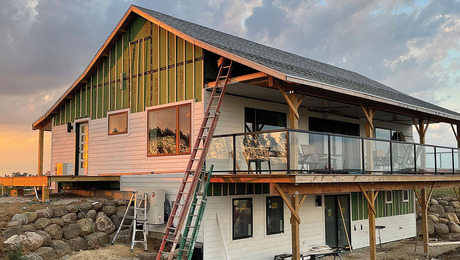Sealing which attic floor????

This is a hundred year old house. Rehabbed by Community Rehab a couple of years ago…moved down the block a few lots. Structurally, it looks like they did a great job. The trim is lacking a bit, but ok.
But they really botched the weatherization. The crawl is a mess and I have found two exterior wall cavities that appear to have no insulation whatsoever (and I’ve only checked a few). And the windows were installed after the fanfold styrofoam with no flashing whatsoever (OK, I only looked at two of them, but….)
But this thread is about the attic. They lowered the ceilings (one story house). Of course, they did not remove the old ceilings, just installed new ones.
There are several places where the orginal ceiling was removed to gain access for installation of lights, vents, etc.
My thought is to use those holes in the same way to seal up around the lights, vents, etc. Then to close up those holes and seal them as best as I can.
QUESTION: What would be the best way to close up those holes (the ones in the orginal ceiling)??? I considered just cutting cardboard to fit, staple it in, foam it tight, and then throw some cells on top…but that doesn’t seem too elegant.
I need to put a ceiling in the furnace room. I think it would be a lot easier to do this from above since there is not a lot of room around the furnace.
QUESTION: Is there any reason why I couldn’t put the drywall on top of the framing?????
Rich Beckman
Another day, another tool.















Replies
Cardboard should work. So should drywall just layed on top of the existing surface. If the hole provides access to electrical boxes, be sure to make it nominally removable. (And it doesn't hurt to write "electrical box" or some such on top.)
The main problem with putting drywall on top of framing in a furnace room is that it (greatly) reduces the fire-stopping ability of the drywall. You have to evaluate whether this is an issue. However, if you can COMPLETELY seal the ceiling working from above, but will necessarily leave holes (larger than 1/4" or so) working from below, then the ceiling above is probably better, since it prevents the chimney effect that can spread file rapidly.
Of course, if the ceiling is a code requirement, it should be installed to code, regardless.
Dan,Thanks. That's an excellent point about possible junction boxes. I might have missed that.Rich BeckmanAnother day, another tool.
I don't totally have the picture of the old and new ceiling config, but how about covering the holes with some of the fanfold foam you mentioned in your post? How much space, if any, is there between the new and old ceiling? Matt
Matt,Originally the ceilings were just under 10 feet or so with a lath/plaster finish. New ceilings were framed in about 18 inches lower and finished with drywall.The opennings in the original ceiling are where the plaster/lath was removed.Fanfold foam is an idea. I hadn't thought of that.Rich BeckmanAnother day, another tool.
wow - that's crazy - why take a 10' tall "grand" room and turn it into an 8.5' economy home... I could see maybe firing the ceiling and hanging new rock but...
Matt
Edited 1/1/2005 8:46 pm ET by DIRISHINME
"why take a 10' tall "grand" room and turn it into an 8.5' economy home..."Well, age and neglect had already turned it into an economy home. I would guess that someone felt it would be easier to heat with lower ceilings (of course, the house is a sieve top to bottom, but lets not try to heat tall ceiling rooms....).Or...there's no accounting for taste.This house was rehabbed by Community Rehab, which means much of the labor was down by the work crew out of the jail. What was done by others was done by the low bid. Materials were what was on clearence or what was donated, or what was intended for another project that then fell through...Rich BeckmanAnother day, another tool.
I'll bet those inmates could do reasonable work if they had qualified leadership.
Just out of curiosity, what is your involvement in this house? Do you own it? Is it for a rental? Or are you hired by the owners to help tighten it up?
Another q: You said >> And the windows were installed after the fanfold styrofoam with no flashing whatsoever (OK, I only looked at two of them, but....) <<
Rich and anyone else: is it common practice to use the fanfold foam as a sheathing wrap? I have seen it done by 1 or 2 builders around here, but was wondering about trapping moisture in the wall assembly. The stuff I have seen used is blue and is about 3/16" thick or so. It does seem like it would make a great water barrier if it were detailed (taped and flashed) properly.
"I'll bet those inmates could do reasonable work if they had qualified leadership."And some of the work is very good. But is also depends on who is in jail at the moment. I used to know a painter who probably spent three months a year in jail on average (quite a drinker). He was (is?) a terrific interior painter. He was really good and worked really fast. So when he was in and on the work crew, the painting was always done by him and it was good.(I understand he withdrew from the work crew when he realized the county was planning on saving lots of money by having him paint the new juvenile detention facility at work crew rates)>But when he wasn't in jail, the painting wasn't as good.I agree with your implied point that the people in charge aparently do not really understand how to do weatherization.
"Just out of curiosity, what is your involvement in this house? Do you own it? Is it for a rental? Or are you hired by the owners to help tighten it up?"I had done just a few small things for the owner at her previous home. But that was enough to convince her I was good. When she bought the house (which was still not finished being rehabbed) she negotiated a laminated floor for the entry/living room/hall. Rehab was willing to pay a bit more for the flooring so she could do that, but they wanted nothing to do with the install. So she called me. I talked her out of the laminate and into a prefinished wood.I did a few other odds and ends in the house at that time. I knew then that the house was a sieve, but no one asked so I kept my opinion to myself.She has been trying to get Rehab to attend to the problems for two years with little luck. Now Rehab is going out of business and calls her and says "How much do you want to settle this. We want to close our books for good in a week." So she is scrambling to determine how much it would cost to fix the house.Since Rehab is now saying they will just give her money instead of fixing it themselves, she immediately called me.
Regarding the windows, I will be starting another thread on that (I didn't want in one day to ask ALL the questions this house raises).The fanfold question is good and probably deserves its own thread. I would never use it as a sheathing wrap (there are better alternatives). I only use it when putting vinyl siding over uneven siding to give a bit of "body" to the vinyl siding. It does seem that if you detail it properly at seams and edges it would do a reasonable job as a water barrier...even as a air/vapor barrier. But I don't really know.Rich BeckmanAnother day, another tool.